Curtobacterium spp. and Curtobacterium flaccumfaciens: Phylogeny, Genomics-Based Taxonomy, Pathogenicity, and Diagnostics
Abstract
1. Introduction
- (a)
- Is there any conflict between the phylogenies calculated from whole-genome sequences and the current classification of the genus Curtobacterium?
- (b)
- Which species within the genus Curtobacterium need to be revised because they are evidently nonmonophyletic?
2. Materials and Methods
2.1. Genomes’ Annotation and Comparison
2.2. ANI Calculation and Clustering
2.3. Phylogenetic Analysis of rRNAs, Ribosomal Proteins, gyrB, parE, rpoA and rpoB
2.4. Phylogenetic Analysis of Core Genome
2.5. Protein Structure Modelling
2.6. Primer Design
2.7. Bacterial Strains and Growth Conditions
2.8. DNA Isolation
2.9. Polymerase Chain Reaction (PCR)
2.10. Test Plasmid Construction
2.11. qPCR Conditions
3. Results
3.1. Curtobacterium Genomes in GenBank Database, Mislabelled Strains, and Curtobacterium flaccumfaciens Pathogenic Strains
3.2. ANI Analysis
3.3. 16 S, 23S, and Concatenated Ribosomal RNA Genes Phylogeny
3.4. gyrB, parE, rpoA, rpoB, and Concatenated Genes Phylogeny
3.5. Ribosomal Proteins Phylogeny
3.6. Multigene-Based Phylogenomic Analysis
3.7. Possible Taxonomy Revisions Based on ANI and Phylogenetic Analysis
3.7.1. Genomospecies 1. Curtobacterium flaccumfaciens
3.7.2. Genomospecies 2
3.7.3. Genomospecies 3–5
3.7.4. Genomospecies 6–10
3.7.5. Genomospecies 11–21
3.7.6. Genomospecies 21–24
3.7.7. Genomospecies 26–33
3.7.8. Genomospecies 34–41
3.7.9. Genomospecies 42–48
3.7.10. Genomospecies 49, 50
3.7.11. C. ammoniigenes NBRC 101786
3.8. Curtobacterium Plasmid pCff1 and Curtobacterium Plasmids
3.9. pCff1 Putative DNA Polymerase Analysis
3.10. Curtobacterium PCR Diagnostics and Genus-Specific Primers
4. Discussion
4.1. Challenges of Curtobacterium Taxonomic Classification
- C. ammoniigenes (Aizawa et al. 2007 [93]);
- C. flaccumfaciens (Hedges 1922). Collins and Jones described this species as a plant pathogen with six recognised pathovars [3];
- C. herbarum (Behrendt et al. 2002 [94]);
- C. oceanosedimentum—approved as a homotypic synonym: Flavobacterium oceanosedimentum Carty and Litchfield 1978 [95];
4.2. Curtobacterium Plasmids and Pathogenicity
4.3. Curtobacterium spp. PCR Diagnostics
5. Conclusions
Supplementary Materials
Author Contributions
Funding
Institutional Review Board Statement
Informed Consent Statement
Conflicts of Interest
References
- Yamada, K.; Komagata, K. Taxonomic Studies on Coryneform Bacteria. J. Gen. Appl. Microbiol. 1972, 18, 417–431. [Google Scholar] [CrossRef]
- Hedges, F. A Bacterial Wilt of the Bean Caused by Bacterium flaccumfaciens Nov. sp. Science 1922, 55, 433–434. [Google Scholar] [CrossRef] [PubMed]
- Collins, M.D.; Jones, D.Y. 1983 Reclassification of Corynebacterium Flaccumfaciens, Corynebacterium Betae, Corynebacterium Oortii and Corynebacterium Poinsettiae in the Genus Curtobacterium, as Curtobacterium flaccumfaciens Comb. Nov. Microbiology 1983, 129, 3545–3548. [Google Scholar] [CrossRef][Green Version]
- Komagata, K.; Suzuki, K.I. Genus Curtobacterium. In Bergeys Manual of Systematic Bacteriology; Springer: Baltimore, MD, USA, 1986; Volume 2, pp. 1313–1317. [Google Scholar]
- Magnani, G.S.; Didonet, C.M.; Cruz, L.M.; Picheth, C.F.; Pedrosa, F.O.; Souza, E.M. Diversity of Endophytic Bacteria in Brazilian Sugarcane. Genet. Mol. Res. GMR 2010, 9, 250–258. [Google Scholar] [CrossRef] [PubMed]
- West, E.R.; Cother, E.J.; Steel, C.C.; Ash, G.J. The Characterization and Diversity of Bacterial Endophytes of Grapevine. Can. J. Microbiol. 2010, 56, 209–216. [Google Scholar] [CrossRef]
- Pereira, S.I.A.; Castro, P.M.L. Diversity and Characterization of Culturable Bacterial Endophytes from Zea Mays and Their Potential as Plant Growth-Promoting Agents in Metal-Degraded Soils. Environ. Sci. Pollut. Res. 2014, 21, 14110–14123. [Google Scholar] [CrossRef] [PubMed]
- Zinniel, D.K.; Lambrecht, P.; Harris, N.B.; Feng, Z.; Kuczmarski, D.; Higley, P.; Ishimaru, C.A.; Arunakumari, A.; Barletta, R.G.; Vidaver, A.K. Isolation and Characterization of Endophytic Colonizing Bacteria from Agronomic Crops and Prairie Plants. Appl. Environ. Microbiol. 2002, 68, 2198–2208. [Google Scholar] [CrossRef] [PubMed]
- Enya, J.; Shinohara, H.; Yoshida, S.; Tsukiboshi, T.; Negishi, H.; Suyama, K.; Tsushima, S. Culturable Leaf-Associated Bacteria on Tomato Plants and Their Potential as Biological Control Agents. Microb. Ecol. 2007, 53, 524–536. [Google Scholar] [CrossRef]
- Vega, F.E.; Pava-Ripoll, M.; Posada, F.; Buyer, J.S. Endophytic Bacteria in Coffea arabica L. J. Basic Microbiol. 2005, 45, 371–380. [Google Scholar] [CrossRef]
- Aravind, R.; Kumar, A.; Eapen, S.J.; Ramana, K.V. Endophytic Bacterial Flora in Root and Stem Tissues of Black Pepper (Piper Nigrum L.) Genotype: Isolation, Identification and Evaluation against Phytophthora capsici. Lett. Appl. Microbiol. 2009, 48, 58–64. [Google Scholar] [CrossRef]
- De Melo Pereira, G.V.; Magalhães, K.T.; Lorenzetii, E.R.; Souza, T.P.; Schwan, R.F. A Multiphasic Approach for the Identification of Endophytic Bacterial in Strawberry Fruit and Their Potential for Plant Growth Promotion. Microb. Ecol. 2012, 63, 405–417. [Google Scholar] [CrossRef]
- Araújo, W.L.; Marcon, J.; Maccheroni, W.; van Elsas, J.D.; van Vuurde, J.W.L.; Azevedo, J.L. Diversity of Endophytic Bacterial Populations and Their Interaction with Xylella Fastidiosa in Citrus Plants. Appl. Environ. Microbiol. 2002, 68, 4906–4914. [Google Scholar] [CrossRef]
- Ulrich, K.; Ulrich, A.; Ewald, D. Diversity of Endophytic Bacterial Communities in Poplar Grown under Field Conditions. FEMS Microbiol. Ecol. 2008, 63, 169–180. [Google Scholar] [CrossRef]
- Procópio, R.E.L.; Araújo, W.L.; Maccheroni, W.; Azevedo, J.L. Characterization of an Endophytic Bacterial Community Associated with Eucalyptus spp. Genet. Mol. Res. GMR 2009, 8, 1408–1422. [Google Scholar] [CrossRef]
- Montero-Calasanz, M.d.C.; Meier-Kolthoff, J.P.; Zhang, D.-F.; Yaramis, A.; Rohde, M.; Woyke, T.; Kyrpides, N.C.; Schumann, P.; Li, W.-J.; Göker, M. Genome-Scale Data Call for a Taxonomic Rearrangement of Geodermatophilaceae. Front. Microbiol. 2017, 8, 2501. [Google Scholar] [CrossRef]
- Breider, S.; Scheuner, C.; Schumann, P.; Fiebig, A.; Petersen, J.; Pradella, S.; Klenk, H.-P.; Brinkhoff, T.; Göker, M. Genome-Scale Data Suggest Reclassifications in the Leisingera-Phaeobacter Cluster Including Proposals for Sedimentitalea Gen. Nov. and Pseudophaeobacter Gen. Nov. Front. Microbiol. 2014, 5, 416. [Google Scholar] [CrossRef]
- Klenk, H.-P.; Göker, M. En Route to a Genome-Based Classification of Archaea and Bacteria? Syst. Appl. Microbiol. 2010, 33, 175–182. [Google Scholar] [CrossRef]
- Hennig, W. Phylogenetic Systematics. Annu. Rev. Entomol. 1965, 10, 97–116. [Google Scholar] [CrossRef]
- Vaghefi, N.; Adorada, D.L.; Huth, L.; Kelly, L.A.; Poudel, B.; Young, A.; Sparks, A.H. Whole-Genome Data from Curtobacterium flaccumfaciens Pv. flaccumfaciens Strains Associated with Tan Spot of Mungbean and Soybean Reveal Diverse Plasmid Profiles. Mol. Plant-Microbe Interact. 2021, 34, 1216–1222. [Google Scholar] [CrossRef]
- Osdaghi, E.; Taghavi, S.M.; Calamai, S.; Biancalani, C.; Cerboneschi, M.; Tegli, S.; Harveson, R.M. Phenotypic and Molecular-Phylogenetic Analysis Provide Novel Insights into the Diversity of Curtobacterium flaccumfaciens. Phytopathology 2018, 108, 1154–1164. [Google Scholar] [CrossRef]
- Chen, G.; Khojasteh, M.; Taheri-Dehkordi, A.; Taghavi, S.M.; Rahimi, T.; Osdaghi, E. Complete Genome Sequencing Provides Novel Insight Into the Virulence Repertories and Phylogenetic Position of Dry Beans Pathogen Curtobacterium flaccumfaciens Pv. Flaccumfaciens. Phytopathology 2021, 111, 268–280. [Google Scholar] [CrossRef] [PubMed]
- O’Leary, M.L.; Gilbertson, R.L. Complete Genome Sequence Resource of a Strain of Curtobacterium flaccumfaciens Pv. Flaccumfaciens, the Causal Agent of Bacterial Wilt of Common Bean, from Turkey. Phytopathology 2020, 110, 2010–2013. [Google Scholar] [CrossRef] [PubMed]
- NCBI. Home—Genome. Available online: https://www.ncbi.nlm.nih.gov/genome (accessed on 11 November 2021).
- Seemann, T. Prokka: Rapid Prokaryotic Genome Annotation. Bioinform. Oxf. Engl. 2014, 30, 2068–2069. [Google Scholar] [CrossRef] [PubMed]
- Hyatt, D.; Chen, G.-L.; LoCascio, P.F.; Land, M.L.; Larimer, F.W.; Hauser, L.J. Prodigal: Prokaryotic Gene Recognition and Translation Initiation Site Identification. BMC Bioinform. 2010, 11, 119. [Google Scholar] [CrossRef]
- Seemann, T. Barrnap. Available online: https://github.com/tseemann/barrnap (accessed on 27 November 2021).
- Geneious|Bioinformatics Software for Sequence Data Analysis. Available online: https://www.geneious.com/ (accessed on 11 November 2021).
- Delcher, A.L.; Bratke, K.A.; Powers, E.C.; Salzberg, S.L. Identifying Bacterial Genes and Endosymbiont DNA with Glimmer. Bioinform. Oxf. Engl. 2007, 23, 673–679. [Google Scholar] [CrossRef]
- Altschul, S.F.; Gish, W.; Miller, W.; Myers, E.W.; Lipman, D.J. Basic Local Alignment Search Tool. J. Mol. Biol. 1990, 215, 403–410. [Google Scholar] [CrossRef]
- Gabler, F.; Nam, S.-Z.; Till, S.; Mirdita, M.; Steinegger, M.; Söding, J.; Lupas, A.N.; Alva, V. Protein Sequence Analysis Using the MPI Bioinformatics Toolkit. Curr. Protoc. Bioinform. 2020, 72, e108. [Google Scholar] [CrossRef]
- Kelley, L.A.; Mezulis, S.; Yates, C.M.; Wass, M.N.; Sternberg, M.J.E. The Phyre2 Web Portal for Protein Modeling, Prediction and Analysis. Nat. Protoc. 2015, 10, 845–858. [Google Scholar] [CrossRef]
- Mitchell, A.L.; Attwood, T.K.; Babbitt, P.C.; Blum, M.; Bork, P.; Bridge, A.; Brown, S.D.; Chang, H.-Y.; El-Gebali, S.; Fraser, M.I.; et al. InterPro in 2019: Improving Coverage, Classification and Access to Protein Sequence Annotations. Nucleic Acids Res. 2019, 47, D351–D360. [Google Scholar] [CrossRef]
- Sullivan, M.J.; Petty, N.K.; Beatson, S.A. Easyfig: A Genome Comparison Visualizer. Bioinformatics 2011, 27, 1009–1010. [Google Scholar] [CrossRef]
- Lee, I.; Ouk Kim, Y.; Park, S.-C.; Chun, J. OrthoANI: An Improved Algorithm and Software for Calculating Average Nucleotide Identity. Int. J. Syst. Evol. Microbiol. 2016, 66, 1100–1103. [Google Scholar] [CrossRef] [PubMed]
- Dereeper, A.; Guignon, V.; Blanc, G.; Audic, S.; Buffet, S.; Chevenet, F.; Dufayard, J.-F.; Guindon, S.; Lefort, V.; Lescot, M.; et al. Phylogeny.Fr: Robust Phylogenetic Analysis for the Non-Specialist. Nucleic Acids Res. 2008, 36, W465–W469. [Google Scholar] [CrossRef] [PubMed]
- Gascuel, O. BIONJ: An Improved Version of the NJ Algorithm Based on a Simple Model of Sequence Data. Mol. Biol. Evol. 1997, 14, 685–695. [Google Scholar] [CrossRef] [PubMed]
- Letunic, I.; Bork, P. Interactive Tree Of Life (ITOL) v5: An Online Tool for Phylogenetic Tree Display and Annotation. Nucleic Acids Res. 2021, 49, W293–W296. [Google Scholar] [CrossRef]
- Katoh, K.; Misawa, K.; Kuma, K.; Miyata, T. MAFFT: A Novel Method for Rapid Multiple Sequence Alignment Based on Fast Fourier Transform. Nucleic Acids Res. 2002, 30, 3059–3066. [Google Scholar] [CrossRef]
- Kumar, S.; Stecher, G.; Li, M.; Knyaz, C.; Tamura, K. MEGA X: Molecular Evolutionary Genetics Analysis across Computing Platforms. Mol. Biol. Evol. 2018, 35, 1547–1549. [Google Scholar] [CrossRef]
- Stamatakis, A. RAxML Version 8: A Tool for Phylogenetic Analysis and Post-Analysis of Large Phylogenies. Bioinform. Oxf. Engl. 2014, 30, 1312–1313. [Google Scholar] [CrossRef]
- Tamura, K.; Nei, M. Estimation of the Number of Nucleotide Substitutions in the Control Region of Mitochondrial DNA in Humans and Chimpanzees. Mol. Biol. Evol. 1993, 10, 512–526. [Google Scholar] [CrossRef]
- Nei, M.; Kumar, S. Molecular Evolution and Phylogenetics; Oxford University Press: Oxford, NY, USA, 2000; ISBN 978-0-19-513585-5. [Google Scholar]
- Tonkin-Hill, G.; MacAlasdair, N.; Ruis, C.; Weimann, A.; Horesh, G.; Lees, J.A.; Gladstone, R.A.; Lo, S.; Beaudoin, C.; Floto, R.A.; et al. Producing Polished Prokaryotic Pangenomes with the Panaroo Pipeline. Genome Biol. 2020, 21, 180. [Google Scholar] [CrossRef]
- Jumper, J.; Evans, R.; Pritzel, A.; Green, T.; Figurnov, M.; Ronneberger, O.; Tunyasuvunakool, K.; Bates, R.; Žídek, A.; Potapenko, A.; et al. Highly Accurate Protein Structure Prediction with AlphaFold. Nature 2021, 596, 583–589. [Google Scholar] [CrossRef]
- Yang, J.; Yan, R.; Roy, A.; Xu, D.; Poisson, J.; Zhang, Y. The I-TASSER Suite: Protein Structure and Function Prediction. Nat. Methods 2015, 12, 7–8. [Google Scholar] [CrossRef] [PubMed]
- Zhang, Y. I-TASSER Server for Protein 3D Structure Prediction. BMC Bioinform. 2008, 9, 40. [Google Scholar] [CrossRef] [PubMed]
- Raman, S.; Vernon, R.; Thompson, J.; Tyka, M.; Sadreyev, R.; Pei, J.; Kim, D.; Kellogg, E.; DiMaio, F.; Lange, O.; et al. Structure Prediction for CASP8 with All-Atom Refinement Using Rosetta. Proteins 2009, 77, 89–99. [Google Scholar] [CrossRef]
- Baek, M.; DiMaio, F.; Anishchenko, I.; Dauparas, J.; Ovchinnikov, S.; Lee, G.R.; Wang, J.; Cong, Q.; Kinch, L.N.; Schaeffer, R.D.; et al. Accurate Prediction of Protein Structures and Interactions Using a Three-Track Neural Network. Science 2021, 373, 871–876. [Google Scholar] [CrossRef] [PubMed]
- McGuffin, L.J.; Aldowsari, F.M.F.; Alharbi, S.M.A.; Adiyaman, R. ModFOLD8: Accurate Global and Local Quality Estimates for 3D Protein Models. Nucleic Acids Res. 2021, 49, W425–W430. [Google Scholar] [CrossRef] [PubMed]
- Adiyaman, R.; McGuffin, L.J. ReFOLD3: Refinement of 3D Protein Models with Gradual Restraints Based on Predicted Local Quality and Residue Contacts. Nucleic Acids Res. 2021, 49, W589–W596. [Google Scholar] [CrossRef] [PubMed]
- PyMOL|Pymol.Org. Available online: https://pymol.org/2/ (accessed on 11 November 2021).
- Primer3Plus. Available online: https://primer3plus.com/ (accessed on 25 November 2021).
- Maringoni, A.C.; Camara, R.C.; Souza, V.L. Semi-Selective Culture Medium for Curtobacterium flaccumfaciens Pv. Flaccumfaciens Isolation from Bean Seeds. Seed Sci. Technol. 2006, 34, 117–124. [Google Scholar] [CrossRef]
- Lukianova, A.A.; Evseev, P.V.; Stakheev, A.A.; Kotova, I.B.; Zavriev, S.K.; Ignatov, A.N.; Miroshnikov, K.A. Development of QPCR Detection Assay for Potato Pathogen Pectobacterium Atrosepticum Based on a Unique Target Sequence. Plants 2021, 10, 355. [Google Scholar] [CrossRef]
- Lukianova, A.; Evseev, P.; Tokmakova, A.; Ignatov, A.; Miroshnikov, K. Analysis of Updated Pectobacteriaceae Sequences Highlights the Need for Taxonomy Revisions. In Proceedings of the 2021 IEEE Ural-Siberian Conference on Computational Technologies in Cognitive Science, Genomics and Biomedicine (CSGB), Novosibirsk-Yekaterinburg, Russia, 26–28 May 2021; pp. 320–324. [Google Scholar]
- Sentausa, E.; Fournier, P.-E. Advantages and Limitations of Genomics in Prokaryotic Taxonomy. Clin. Microbiol. Infect. Off. Publ. Eur. Soc. Clin. Microbiol. Infect. Dis. 2013, 19, 790–795. [Google Scholar] [CrossRef]
- Thompson, C.C.; Chimetto, L.; Edwards, R.A.; Swings, J.; Stackebrandt, E.; Thompson, F.L. Microbial Genomic Taxonomy. BMC Genomics 2013, 14, 913. [Google Scholar] [CrossRef]
- Rosselló-Móra, R.; Amann, R. Past and Future Species Definitions for Bacteria and Archaea. Syst. Appl. Microbiol. 2015, 38, 209–216. [Google Scholar] [CrossRef]
- Chun, J.; Oren, A.; Ventosa, A.; Christensen, H.; Arahal, D.R.; da Costa, M.S.; Rooney, A.P.; Yi, H.; Xu, X.-W.; De Meyer, S.; et al. Proposed Minimal Standards for the Use of Genome Data for the Taxonomy of Prokaryotes. Int. J. Syst. Evol. Microbiol. 2018, 68, 461–466. [Google Scholar] [CrossRef]
- Figueras, M.J.; Beaz-Hidalgo, R.; Hossain, M.J.; Liles, M.R. Taxonomic Affiliation of New Genomes Should Be Verified Using Average Nucleotide Identity and Multilocus Phylogenetic Analysis. Genome Announc. 2014, 2, e00927-14. [Google Scholar] [CrossRef]
- Jain, C.; Rodriguez-R, L.M.; Phillippy, A.M.; Konstantinidis, K.T.; Aluru, S. High Throughput ANI Analysis of 90K Prokaryotic Genomes Reveals Clear Species Boundaries. Nat. Commun. 2018, 9, 5114. [Google Scholar] [CrossRef]
- Zhang, Y.; Qiu, S. Examining Phylogenetic Relationships of Erwinia and Pantoea Species Using Whole Genome Sequence Data. Antonie Leeuwenhoek 2015, 108, 1037–1046. [Google Scholar] [CrossRef]
- Goris, J.; Konstantinidis, K.T.; Klappenbach, J.A.; Coenye, T.; Vandamme, P.; Tiedje, J.M. DNA-DNA Hybridization Values and Their Relationship to Whole-Genome Sequence Similarities. Int. J. Syst. Evol. Microbiol. 2007, 57, 81–91. [Google Scholar] [CrossRef]
- Richter, M.; Rosselló-Móra, R. Shifting the Genomic Gold Standard for the Prokaryotic Species Definition. Proc. Natl. Acad. Sci. USA 2009, 106, 19126–19131. [Google Scholar] [CrossRef]
- Kostas Lab|ANI Calculator. Available online: http://enve-omics.ce.gatech.edu/ani/ (accessed on 12 November 2021).
- Ågren, J.; Sundström, A.; Håfström, T.; Segerman, B. Gegenees: Fragmented Alignment of Multiple Genomes for Determining Phylogenomic Distances and Genetic Signatures Unique for Specified Target Groups. PLoS ONE 2012, 7, e39107. [Google Scholar] [CrossRef]
- USEARCH Download. Available online: https://drive5.com/usearch/download.html (accessed on 12 November 2021).
- Barco, R.A.; Garrity, G.M.; Scott, J.J.; Amend, J.P.; Nealson, K.H.; Emerson, D. A Genus Definition for Bacteria and Archaea Based on a Standard Genome Relatedness Index. mBio 2020, 11, e02475-19. [Google Scholar] [CrossRef]
- Mysara, M.; Vandamme, P.; Props, R.; Kerckhof, F.-M.; Leys, N.; Boon, N.; Raes, J.; Monsieurs, P. Reconciliation between Operational Taxonomic Units and Species Boundaries. FEMS Microbiol. Ecol. 2017, 93. [Google Scholar] [CrossRef]
- Ludwig, W.; Schleifer, K.H. Bacterial Phylogeny Based on 16S and 23S RRNA Sequence Analysis. FEMS Microbiol. Rev. 1994, 15, 155–173. [Google Scholar] [CrossRef] [PubMed]
- Větrovský, T.; Baldrian, P. The Variability of the 16S RRNA Gene in Bacterial Genomes and Its Consequences for Bacterial Community Analyses. PLoS ONE 2013, 8, e57923. [Google Scholar] [CrossRef] [PubMed]
- Espejo, R.T.; Plaza, N. Multiple Ribosomal RNA Operons in Bacteria; Their Concerted Evolution and Potential Consequences on the Rate of Evolution of Their 16S RRNA. Front. Microbiol. 2018, 9, 1232. [Google Scholar] [CrossRef] [PubMed]
- Yamamoto, S.; Harayama, S. PCR Amplification and Direct Sequencing of GyrB Genes with Universal Primers and Their Application to the Detection and Taxonomic Analysis of Pseudomonas Putida Strains. Appl. Environ. Microbiol. 1995, 61, 1104–1109. [Google Scholar] [CrossRef]
- Huang, W.M. Bacterial Diversity Based on Type II DNA Topoisomerase Genes. Annu. Rev. Genet. 1996, 30, 79–107. [Google Scholar] [CrossRef]
- Park, H.K.; Yoon, J.W.; Shin, J.W.; Kim, J.Y.; Kim, W. RpoA Is a Useful Gene for Identification and Classification of Streptococcus Pneumoniae from the Closely Related Viridans Group Streptococci. FEMS Microbiol. Lett. 2010, 305, 58–64. [Google Scholar] [CrossRef]
- Soler, L.; Figueras, M.J.; Chacón, M.R.; Guarro, J.; Martinez-Murcia, A.J. Comparison of Three Molecular Methods for Typing Aeromonas Popoffii Isolates. Antonie Leeuwenhoek 2003, 83, 341–349. [Google Scholar] [CrossRef]
- Küpfer, M.; Kuhnert, P.; Korczak, B.M.; Peduzzi, R.; Demarta, A. Genetic Relationships of Aeromonas Strains Inferred from 16S RRNA, GyrB and RpoB Gene Sequences. Int. J. Syst. Evol. Microbiol. 2006, 56, 2743–2751. [Google Scholar] [CrossRef]
- Fang, Y.; Wang, Y.; Liu, Z.; Dai, H.; Cai, H.; Li, Z.; Du, Z.; Wang, X.; Jing, H.; Wei, Q.; et al. Multilocus Sequence Analysis, a Rapid and Accurate Tool for Taxonomic Classification, Evolutionary Relationship Determination, and Population Biology Studies of the Genus Shewanella. Appl. Environ. Microbiol. 2019, 85, e03126-18. [Google Scholar] [CrossRef]
- Ramulu, H.G.; Groussin, M.; Talla, E.; Planel, R.; Daubin, V.; Brochier-Armanet, C. Ribosomal Proteins: Toward a next Generation Standard for Prokaryotic Systematics? Mol. Phylogenet. Evol. 2014, 75, 103–117. [Google Scholar] [CrossRef]
- Wolf, Y.I.; Rogozin, I.B.; Grishin, N.V.; Tatusov, R.L.; Koonin, E.V. Genome Trees Constructed Using Five Different Approaches Suggest New Major Bacterial Clades. BMC Evol. Biol. 2001, 1, 8. [Google Scholar] [CrossRef]
- Roberts, E.; Sethi, A.; Montoya, J.; Woese, C.R.; Luthey-Schulten, Z. Molecular Signatures of Ribosomal Evolution. Proc. Natl. Acad. Sci. USA 2008, 105, 13953–13958. [Google Scholar] [CrossRef]
- Jolley, K.A.; Bliss, C.M.; Bennett, J.S.; Bratcher, H.B.; Brehony, C.; Colles, F.M.; Wimalarathna, H.; Harrison, O.B.; Sheppard, S.K.; Cody, A.J.; et al. Ribosomal Multilocus Sequence Typing: Universal Characterization of Bacteria from Domain to Strain. Microbiol. Read. Engl. 2012, 158, 1005–1015. [Google Scholar] [CrossRef]
- Yutin, N.; Puigbò, P.; Koonin, E.V.; Wolf, Y.I. Phylogenomics of Prokaryotic Ribosomal Proteins. PLoS ONE 2012, 7, e36972. [Google Scholar] [CrossRef]
- Martini, M.; Lee, I.-M.; Bottner, K.D.; Zhao, Y.; Botti, S.; Bertaccini, A.; Harrison, N.A.; Carraro, L.; Marcone, C.; Khan, A.J.; et al. Ribosomal Protein Gene-Based Phylogeny for Finer Differentiation and Classification of Phytoplasmas. Int. J. Syst. Evol. Microbiol. 2007, 57, 2037–2051. [Google Scholar] [CrossRef]
- Pem, D.; Jeewon, R.; Selcuk, F.; Ulukapi, M.; Bhat, J.; Doilom, M.; Lumyong, S.; Hyde, K.D. Ribosomal and Protein Gene Phylogeny Reveals Novel Saprobic Fungal Species From Juglans Regia and Urtica Dioica. Front. Microbiol. 2020, 11, 1303. [Google Scholar] [CrossRef]
- Ciccarelli, F.D.; Doerks, T.; von Mering, C.; Creevey, C.J.; Snel, B.; Bork, P. Toward Automatic Reconstruction of a Highly Resolved Tree of Life. Science 2006, 311, 1283–1287. [Google Scholar] [CrossRef]
- Inglin, R.C.; Meile, L.; Stevens, M.J.A. Clustering of Pan- and Core-Genome of Lactobacillus Provides Novel Evolutionary Insights for Differentiation. BMC Genomics 2018, 19, 284. [Google Scholar] [CrossRef]
- Wu, M.; Scott, A.J. Phylogenomic Analysis of Bacterial and Archaeal Sequences with AMPHORA2. Bioinform. Oxf. Engl. 2012, 28, 1033–1034. [Google Scholar] [CrossRef]
- Segata, N.; Börnigen, D.; Morgan, X.C.; Huttenhower, C. PhyloPhlAn Is a New Method for Improved Phylogenetic and Taxonomic Placement of Microbes. Nat. Commun. 2013, 4, 2304. [Google Scholar] [CrossRef]
- Blanco, L.; Salas, M. Replication of Phage Phi 29 DNA with Purified Terminal Protein and DNA Polymerase: Synthesis of Full-Length Phi 29 DNA. Proc. Natl. Acad. Sci. USA 1985, 82, 6404–6408. [Google Scholar] [CrossRef] [PubMed]
- Komagata, K.; Iizuka, K. Studies on the Microorganisms of Cereal Grains. Part VII. New Species of Brevibacterium Isolated from Rice. J. Agr. Chem. Soc. 1964, 38, 496–502. [Google Scholar]
- Aizawa, T.; Ve, N.B.; Kimoto, K.I.; Iwabuchi, N.; Sumida, H.; Hasegawa, I.; Sasaki, S.; Tamura, T.; Kudo, T.; Suzuki, K.I.; et al. Curtobacterium ammoniigenes sp. nov., an Ammonia-Producing Bacterium Isolated from Plants Inhabiting Acidic Swamps in Actual Acid Sulfate Soil Areas of Vietnam. Int. J. Syst. Evol. Microbiol. 2007, 57, 1447–1452. [Google Scholar] [CrossRef] [PubMed]
- Behrendt, U.; Ulrich, A.; Schumann, P.; Naumann, D.; Suzuki, K. 2002 Diversity of Grass-Associated Microbacteriaceae Isolated from the Phyllosphere and Litter Layer after Mulching the Sward; Polyphasic Characterization of Subtercola pratensis sp. nov., Curtobacterium herbarum sp. nov. and Plantibacter flavus Gen. Nov., sp. Nov. Int. J. Syst. Evol. Microbiol. 2002, 52, 1441–1454. [Google Scholar] [CrossRef] [PubMed]
- Carty, C.E.; Litchfield, C.D. Characterization of a New Marine Sedimentary Bacterium as Flavobacterium Oceanosedimentum Sp. Nov. Int. J. Syst. Bacteriol. 1978, 28, 561–566. [Google Scholar] [CrossRef]
- Seaton, S.; Lemaire, J.; Inderbitzin, P.; Knight-Connoni, V.; White, J.F.; Trujillo, M.E. Curtobacterium glycinis sp. nov. from Glycine max, Curtobacterium gossypii sp. nov. from Gossypium hirsutum and Curtobacterium oryzae sp. nov. from Oryza sativa, Three New Curtobacterium Species and Endophytes from Agricultural Crops. bioRxiv 2021. [Google Scholar] [CrossRef]
- Kim, M.; Oh, H.-S.; Park, S.-C.; Chun, J. Towards a Taxonomic Coherence between Average Nucleotide Identity and 16S RRNA Gene Sequence Similarity for Species Demarcation of Prokaryotes. Int. J. Syst. Evol. Microbiol. 2014, 64, 346–351. [Google Scholar] [CrossRef]
- Gonçalves, R.M.; Balbi-Peña, M.I.; Soman, J.M.; Maringoni, A.C.; Taghouti, G.; Fischer-Le Saux, M.; Portier, P. Genetic Diversity of Curtobacterium flaccumfaciens Revealed by Multilocus Sequence Analysis. Eur. J. Plant Pathol. 2019, 154, 189–202. [Google Scholar] [CrossRef]
- Dimkić, I.; Bhardwaj, V.; Carpentieri-Pipolo, V.; Kuzmanović, N.; Degrassi, G. The Chitinolytic Activity of the Curtobacterium Sp. Isolated from Field-Grown Soybean and Analysis of Its Genome Sequence. PLoS ONE 2021, 16, e0259465. [Google Scholar] [CrossRef]
- Murray, C.S.; Gao, Y.; Wu, M. Re-Evaluating the Evidence for a Universal Genetic Boundary among Microbial Species. Nat. Commun. 2021, 12, 4059. [Google Scholar] [CrossRef]
- Rodriguez-R, L.M.; Jain, C.; Conrad, R.E.; Aluru, S.; Konstantinidis, K.T. Reply to: “Re-Evaluating the Evidence for a Universal Genetic Boundary among Microbial Species”. Nat. Commun. 2021, 12, 4060. [Google Scholar] [CrossRef]
- Schierstaedt, J.; Bziuk, N.; Kuzmanović, N.; Blau, K.; Smalla, K.; Jechalke, S. Role of Plasmids in Plant-Bacteria Interactions. Curr. Issues Mol. Biol. 2019, 30, 17–38. [Google Scholar] [CrossRef]
- Wolter, L.A.; Wietz, M.; Ziesche, L.; Breider, S.; Leinberger, J.; Poehlein, A.; Daniel, R.; Schulz, S.; Brinkhoff, T. Pseudooceanicola Algae Sp. Nov., Isolated from the Marine Macroalga Fucus Spiralis, Shows Genomic and Physiological Adaptations for an Algae-Associated Lifestyle. Syst. Appl. Microbiol. 2021, 44, 126166. [Google Scholar] [CrossRef]
- Sundin, G.W. Genomic Insights into the Contribution of Phytopathogenic Bacterial Plasmids to the Evolutionary History of Their Hosts. Annu. Rev. Phytopathol. 2007, 45, 129–151. [Google Scholar] [CrossRef]
- Brader, G.; Compant, S.; Vescio, K.; Mitter, B.; Trognitz, F.; Ma, L.-J.; Sessitsch, A. Ecology and Genomic Insights into Plant-Pathogenic and Plant-Nonpathogenic Endophytes. Annu. Rev. Phytopathol. 2017, 55, 61–83. [Google Scholar] [CrossRef]
- Leger, R.J.S.; Joshi, L.; Roberts, D.W. Adaptation of Proteases and Carbohydrates of Saprophytic, Phytopathogenic and Entomopathogenic Fungi to the Requirements of Their Ecological Niches. Microbiol. Read. Engl. 1997, 143 Pt 6, 1983–1992. [Google Scholar] [CrossRef]
- Inácio, F.D.; Ferreira, R.O.; de Araujo, C.A.V.; Brugnari, T.; Castoldi, R.; Peralta, R.M.; Souza, C.G.M. de Proteases of Wood Rot Fungi with Emphasis on the Genus Pleurotus. BioMed Res. Int. 2015, 2015, e290161. [Google Scholar] [CrossRef]
- Gill, S.; Krupovic, M.; Desnoues, N.; Béguin, P.; Sezonov, G.; Forterre, P. A Highly Divergent Archaeo-Eukaryotic Primase from the Thermococcus Nautilus Plasmid, PTN2. Nucleic Acids Res. 2014, 42, 3707–3719. [Google Scholar] [CrossRef]
- Sarkisian, N.N.; Antonian, R.G.; Svetlova, M.P.; Ktsoian, Z.A.; Tomilin, N.V. [R-factor from the natural strain of Salmonella derby carrying a DNA-polymerase gene]. Biokhimiia Mosc. Russ. 1985, 50, 673–679. [Google Scholar]
- Kolkenbrock, S.; Naumann, B.; Hippler, M.; Fetzner, S. A Novel Replicative Enzyme Encoded by the Linear Arthrobacter Plasmid PAL1. J. Bacteriol. 2010, 192, 4935–4943. [Google Scholar] [CrossRef]
- Goldsmith, M.; Sarov-Blat, L.; Livneh, Z. Plasmid-Encoded MucB Protein Is a DNA Polymerase (Pol RI) Specialized for Lesion Bypass in the Presence of MucA’, RecA, and SSB. Proc. Natl. Acad. Sci. USA 2000, 97, 11227–11231. [Google Scholar] [CrossRef] [PubMed]
- Tark, M.; Tover, A.; Tarassova, K.; Tegova, R.; Kivi, G.; Hõrak, R.; Kivisaar, M. A DNA Polymerase V Homologue Encoded by TOL Plasmid PWW0 Confers Evolutionary Fitness on Pseudomonas Putida under Conditions of Environmental Stress. J. Bacteriol. 2005, 187, 5203–5213. [Google Scholar] [CrossRef] [PubMed]
- Kim, E.K.; Jeong, J.H.; Youn, H.S.; Koo, Y.B.; Roe, J.H. The Terminal Protein of a Linear Mitochondrial Plasmid Is Encoded in the N-Terminus of the DNA Polymerase Gene in White-Rot Fungus Pleurotus Ostreatus. Curr. Genet. 2000, 38, 283–290. [Google Scholar] [CrossRef]
- Andrade, B.S.; Taranto, A.G.; Góes-Neto, A.; Duarte, A.A. Comparative Modeling of DNA and RNA Polymerases from Moniliophthora Perniciosa Mitochondrial Plasmid. Theor. Biol. Med. Model. 2009, 6, 22. [Google Scholar] [CrossRef][Green Version]
- Fukuda, K.; Maebuchi, M.; Takata, H.; Gunge, N. The Linear Plasmid PDHL1 from Debaryomyces Hansenii Encodes a Protein Highly Homologous to the PGKL1-Plasmid DNA Polymerase. Yeast Chichester Engl. 1997, 13, 613–620. [Google Scholar] [CrossRef]
- Hermanns, J.; Osiewacz, H.D. The Linear Mitochondrial Plasmid PAL2-1 of a Long-Lived Podospora Anserina Mutant Is an Invertron Encoding a DNA and RNA Polymerase. Curr. Genet. 1992, 22, 491–500. [Google Scholar] [CrossRef]
- Li, Q.; Nargang, F.E. Two Neurospora Mitochondrial Plasmids Encode DNA Polymerases Containing Motifs Characteristic of Family B DNA Polymerases but Lack the Sequence Asp-Thr-Asp. Proc. Natl. Acad. Sci. USA 1993, 90, 4299–4303. [Google Scholar] [CrossRef]
- Jung, G.H.; Leavitt, M.C.; Ito, J. Yeast Killer Plasmid PGKL1 Encodes a DNA Polymerase Belonging to the Family B DNA Polymerases. Nucleic Acids Res. 1987, 15, 9088. [Google Scholar] [CrossRef]
- Oeser, B.; Tudzynski, P. The Linear Mitochondrial Plasmid PClK1 of the Phytopathogenic Fungus Claviceps Purpurea May Code for a DNA Polymerase and an RNA Polymerase. Mol. Gen. Genet. MGG 1989, 217, 132–140. [Google Scholar] [CrossRef]
- Ravin, N.V. N15: The Linear Phage-Plasmid. Plasmid 2011, 65, 102–109. [Google Scholar] [CrossRef]
- Jannière, L.; Bidnenko, V.; McGovern, S.; Ehrlich, S.D.; Petit, M.A. Replication Terminus for DNA Polymerase I during Initiation of PAM Beta 1 Replication: Role of the Plasmid-Encoded Resolution System. Mol. Microbiol. 1997, 23, 525–535. [Google Scholar] [CrossRef]
- Díaz, A.; Lacks, S.A.; López, P. Multiple Roles for DNA Polymerase I in Establishment and Replication of the Promiscuous Plasmid PLS1. Mol. Microbiol. 1994, 14, 773–783. [Google Scholar] [CrossRef]
- Allen, J.M.; Simcha, D.M.; Ericson, N.G.; Alexander, D.L.; Marquette, J.T.; Van Biber, B.P.; Troll, C.J.; Karchin, R.; Bielas, J.H.; Loeb, L.A.; et al. Roles of DNA Polymerase I in Leading and Lagging-Strand Replication Defined by a High-Resolution Mutation Footprint of ColE1 Plasmid Replication. Nucleic Acids Res. 2011, 39, 7020–7033. [Google Scholar] [CrossRef]
- Guimaraĕs, P.M.; Palmano, S.; Smith, J.J.; Grossi de Sá, M.F.; Saddler, G.S. Development of a PCR Test for the Detection of Curtobacterium flaccumfaciens Pv. Flaccumfaciens. Antonie Van Leeuwenhoek 2001, 80, 1–10. [Google Scholar] [CrossRef]
- Zijlstra, C.; De Haas, L.G.; Krijger, M.; Verstappen, E.; Warris, S.; de Haan, E.; van der Wolf, J. Development and Evaluation of Two TaqMan Assays for Generic Detection of Dickeya Species. Eur. J. Plant Pathol. 2020, 156, 311–316. [Google Scholar] [CrossRef]
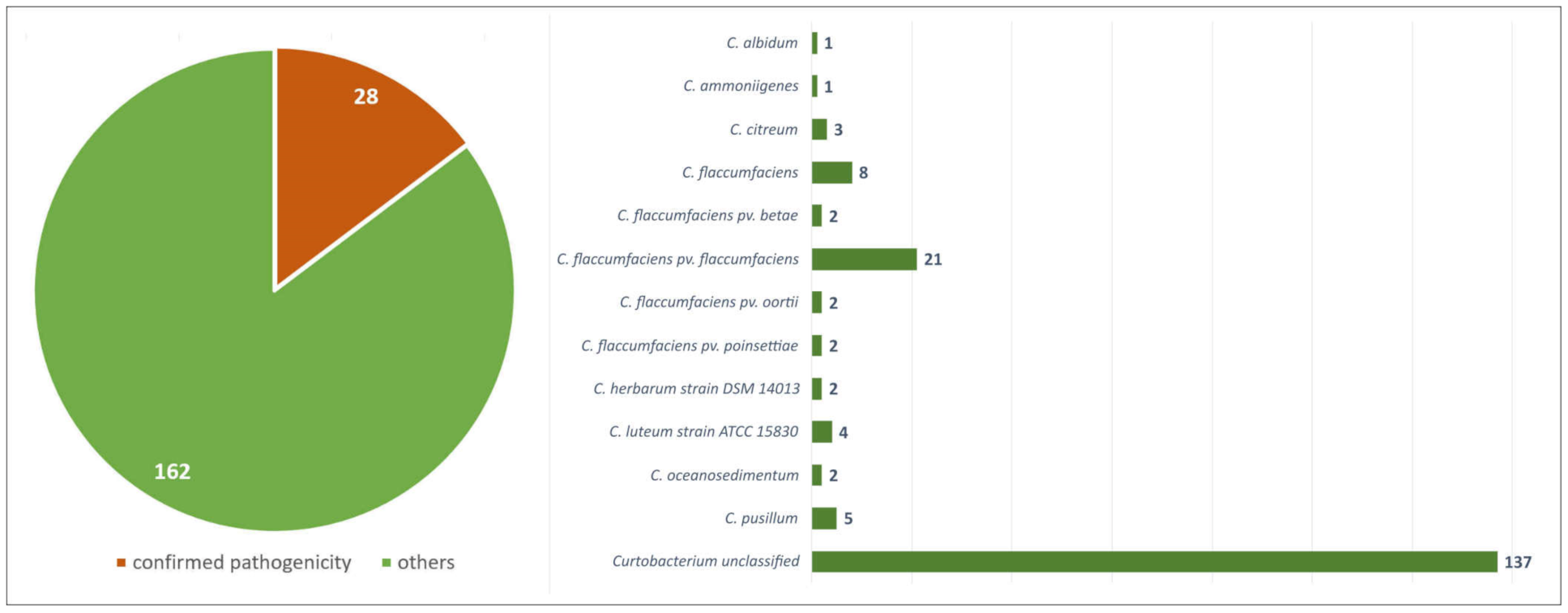
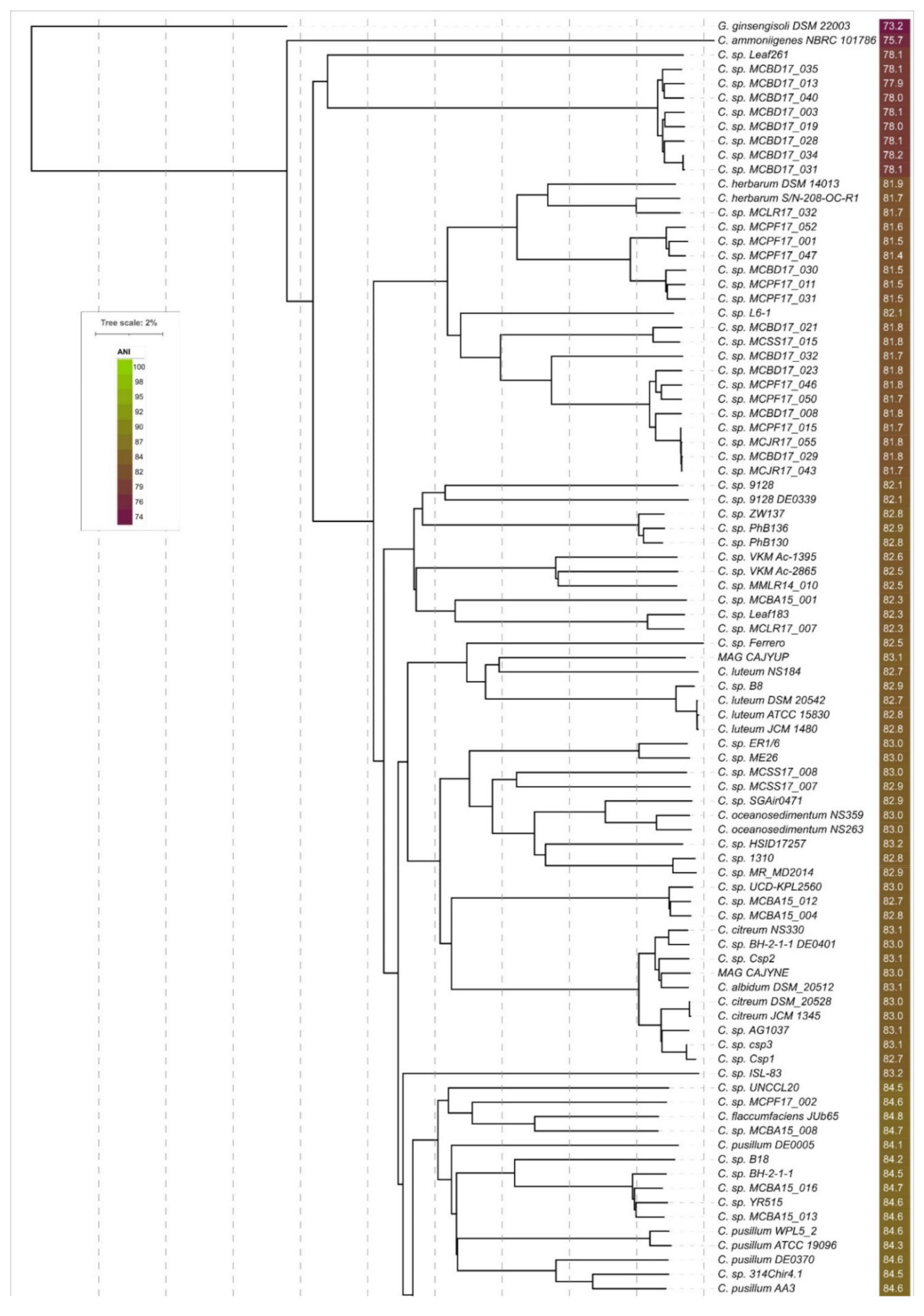
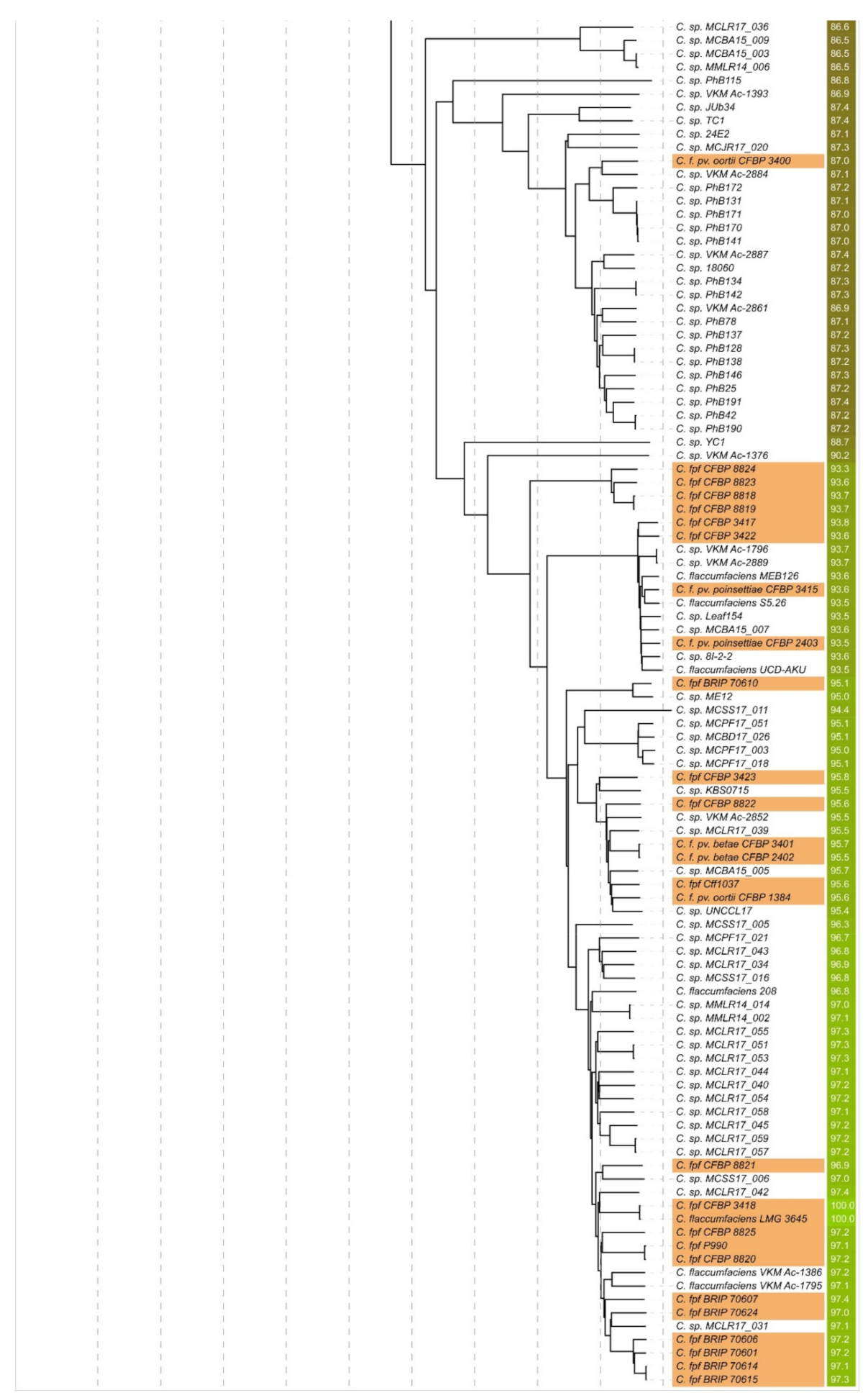


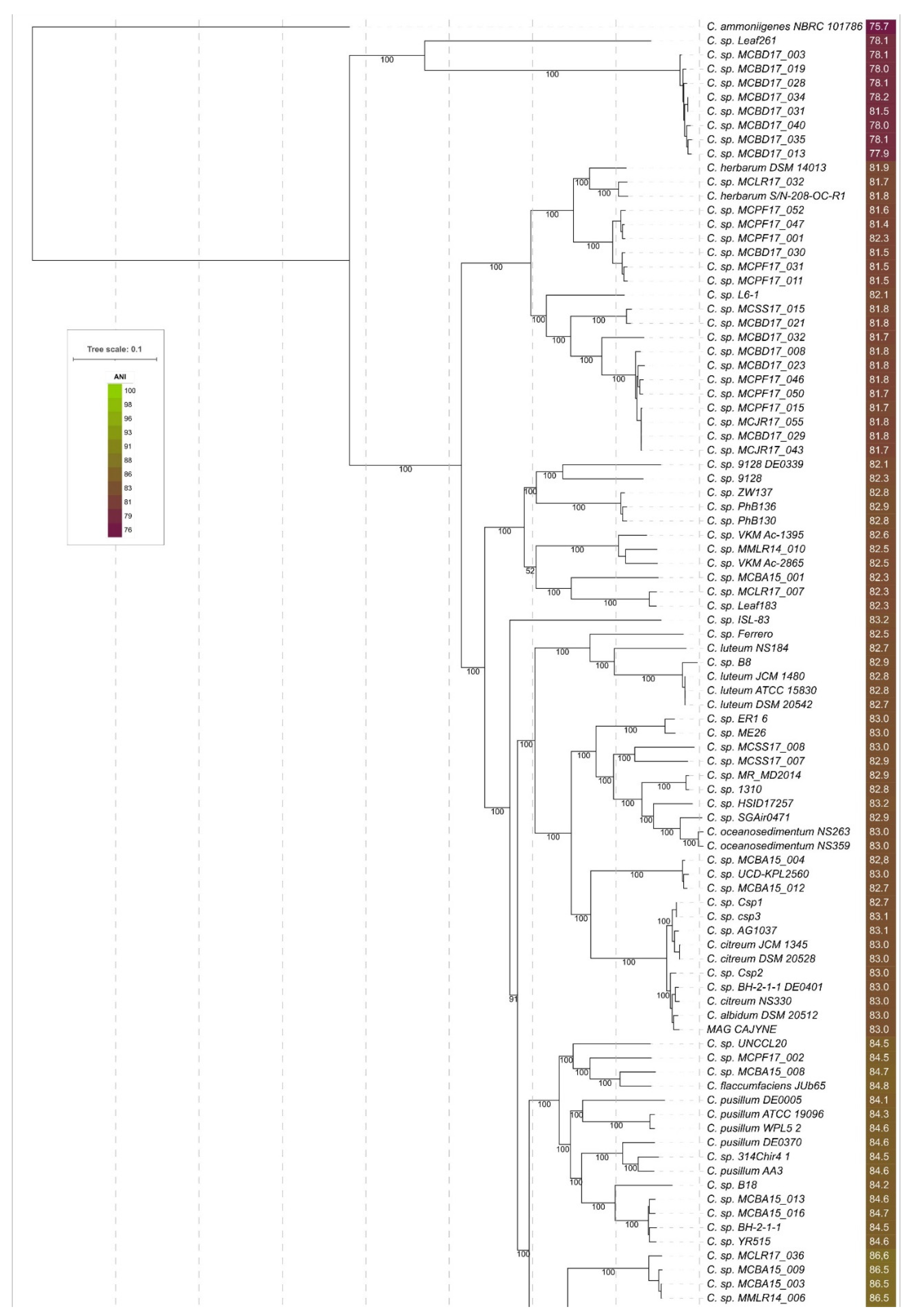
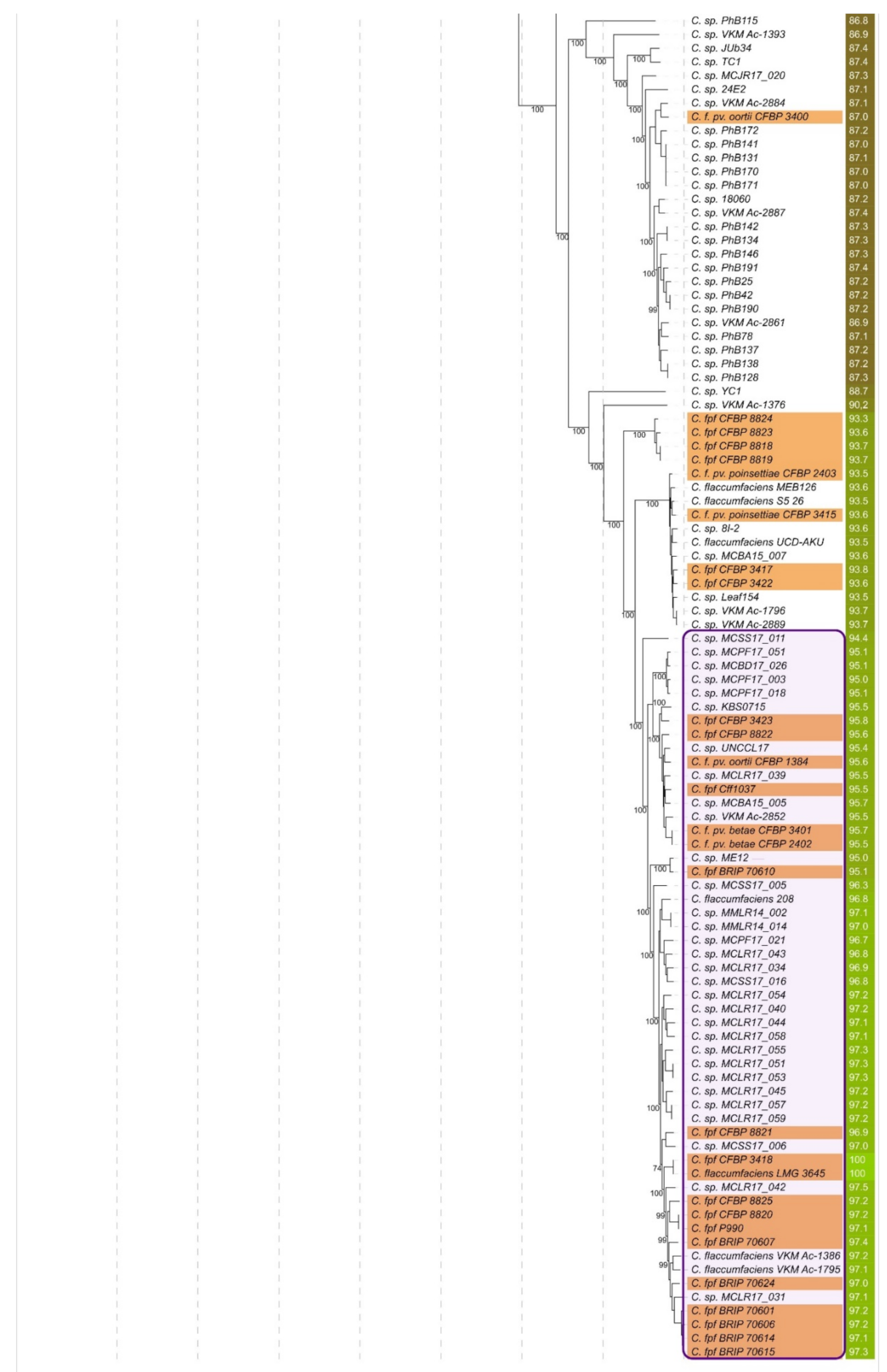
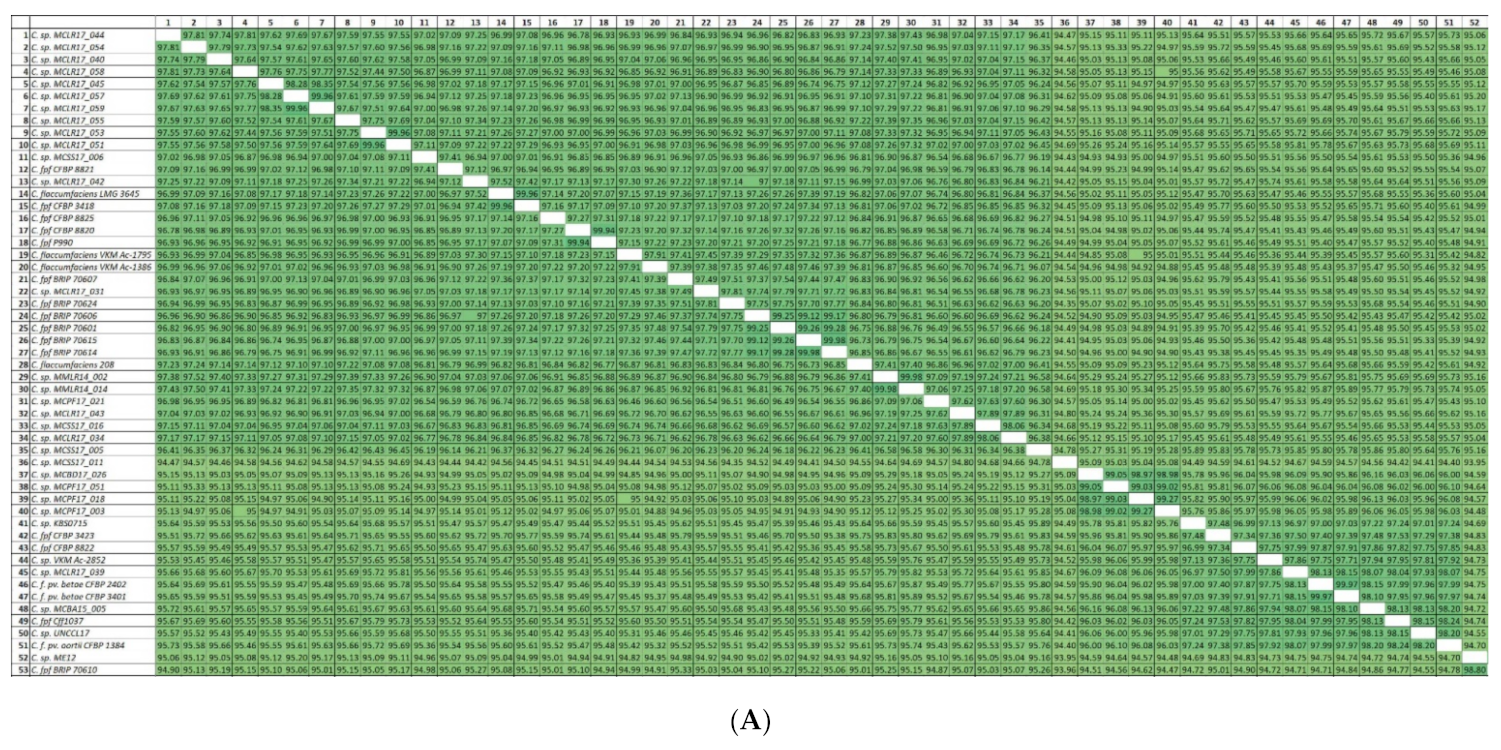
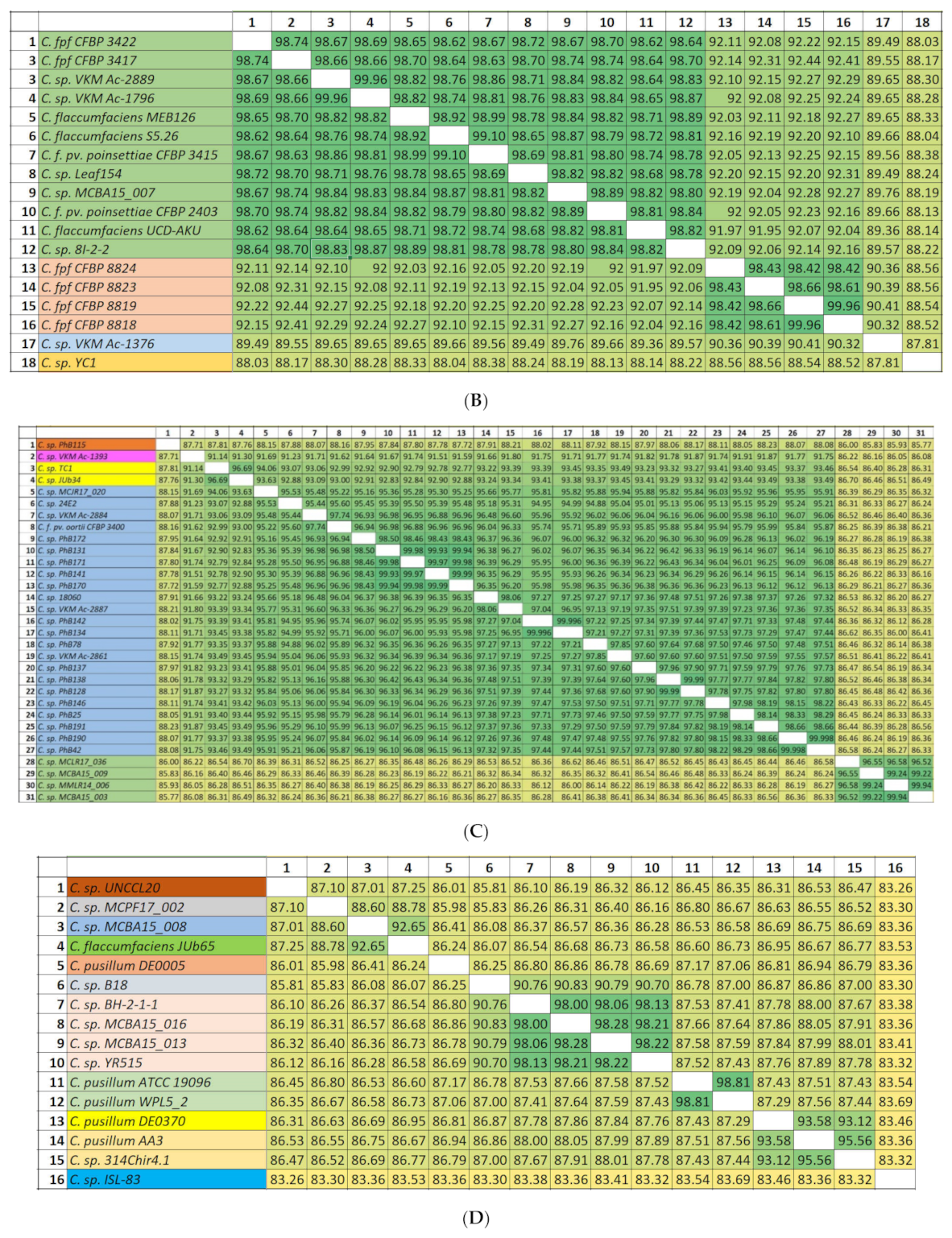
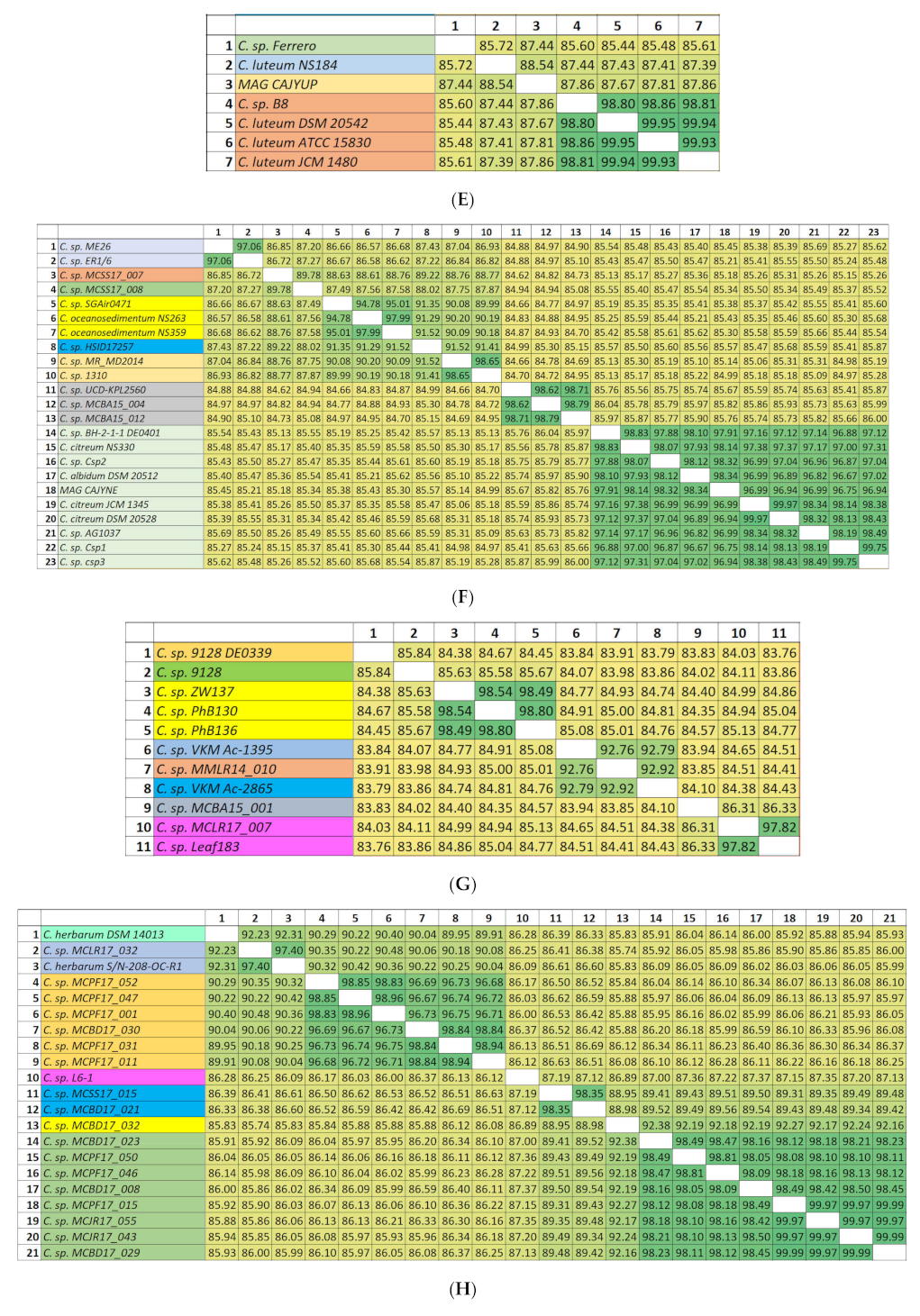

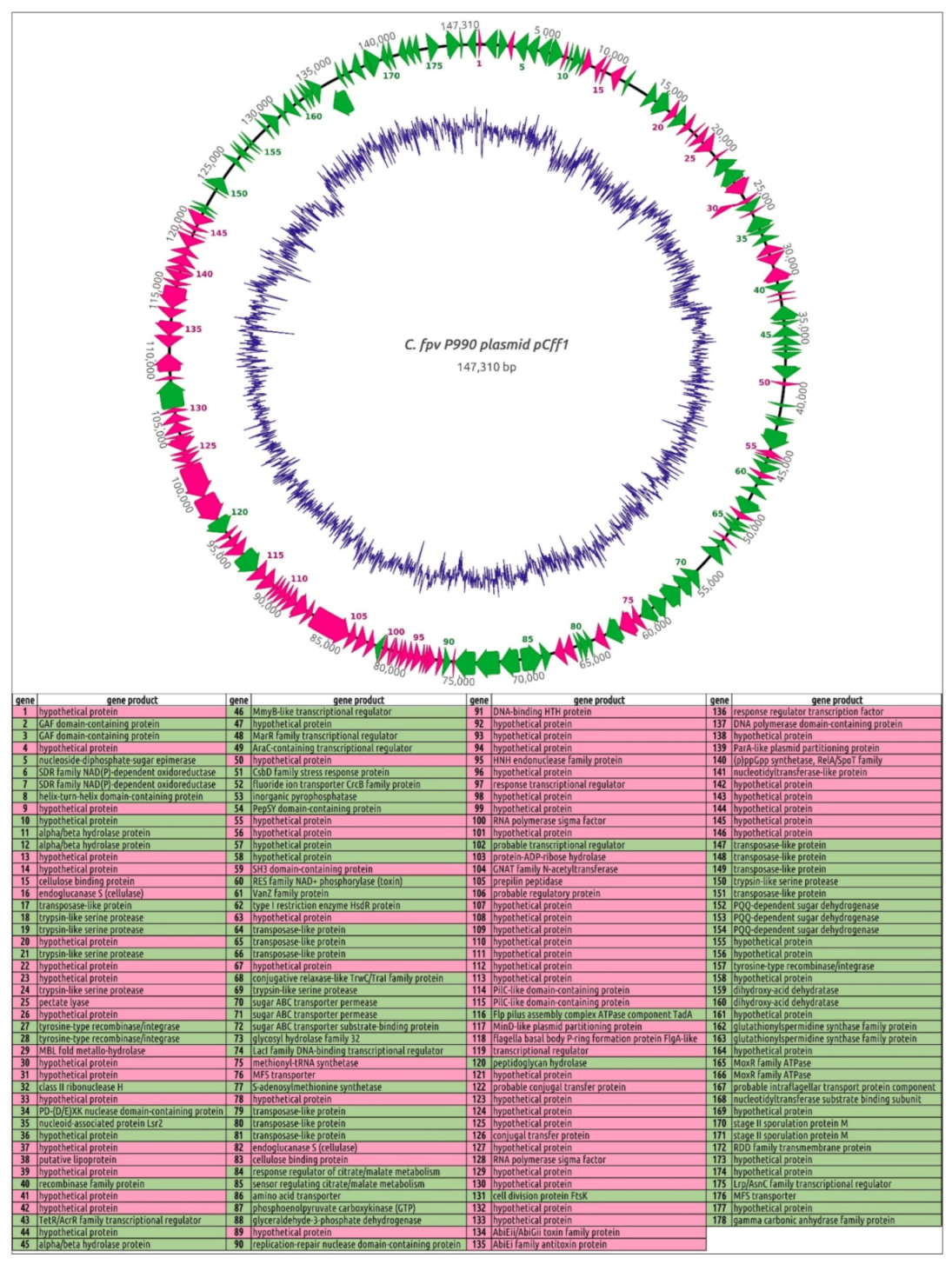
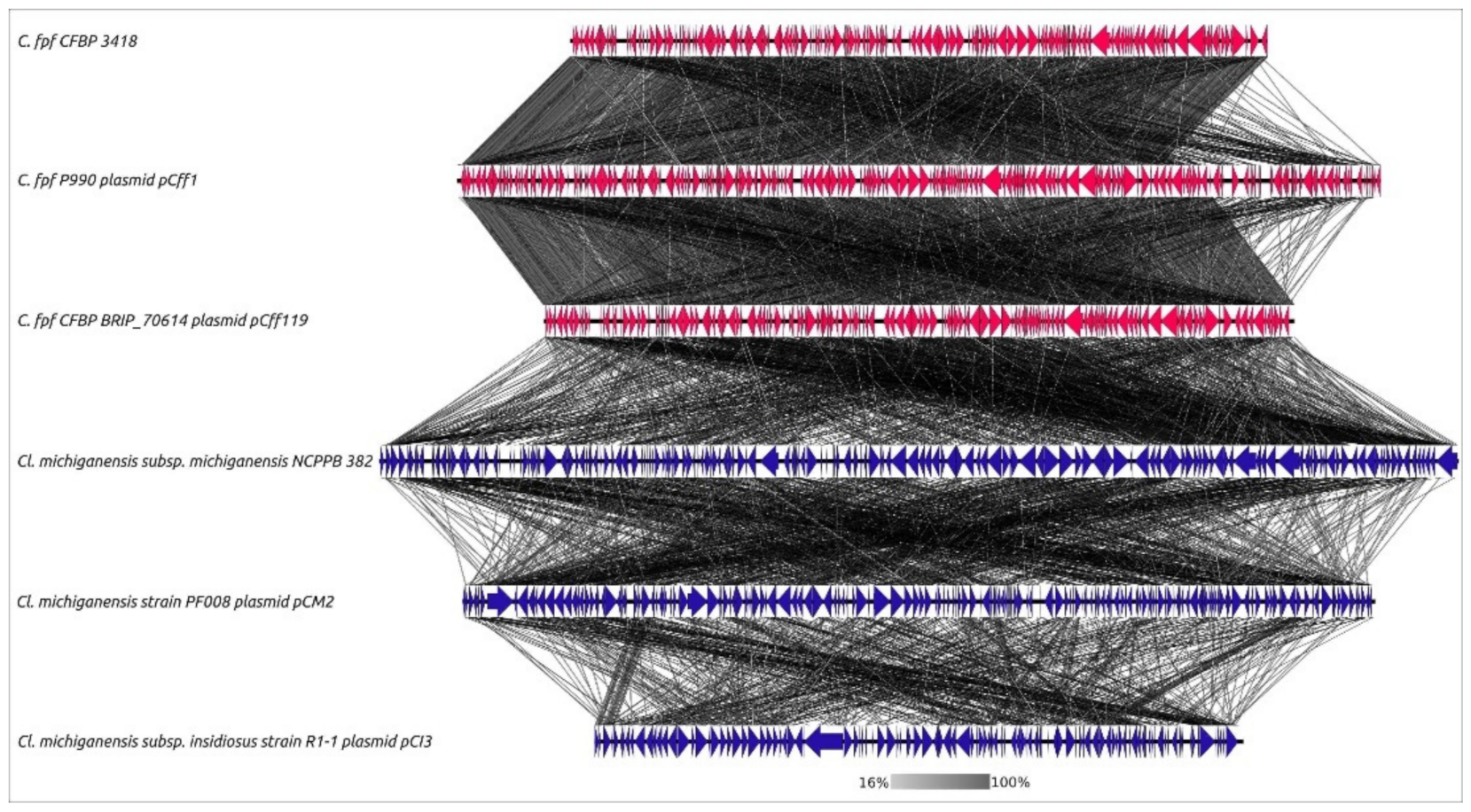

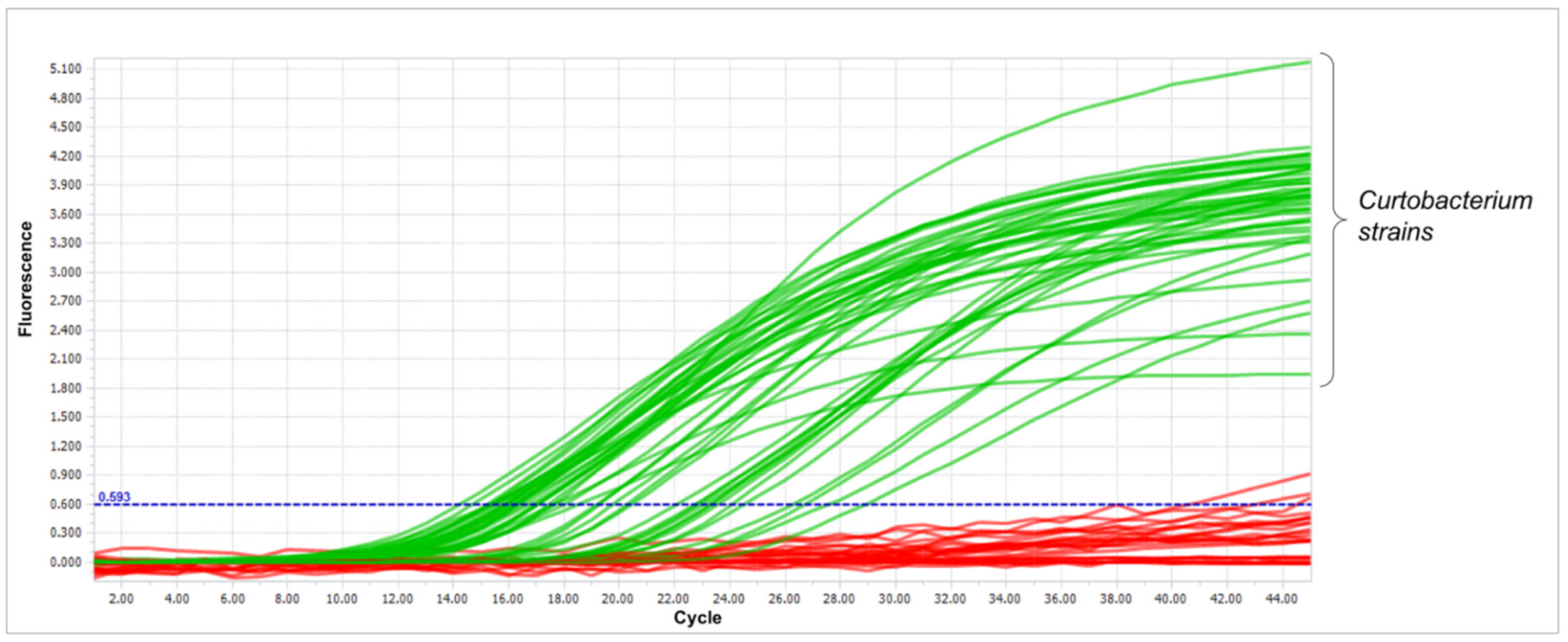
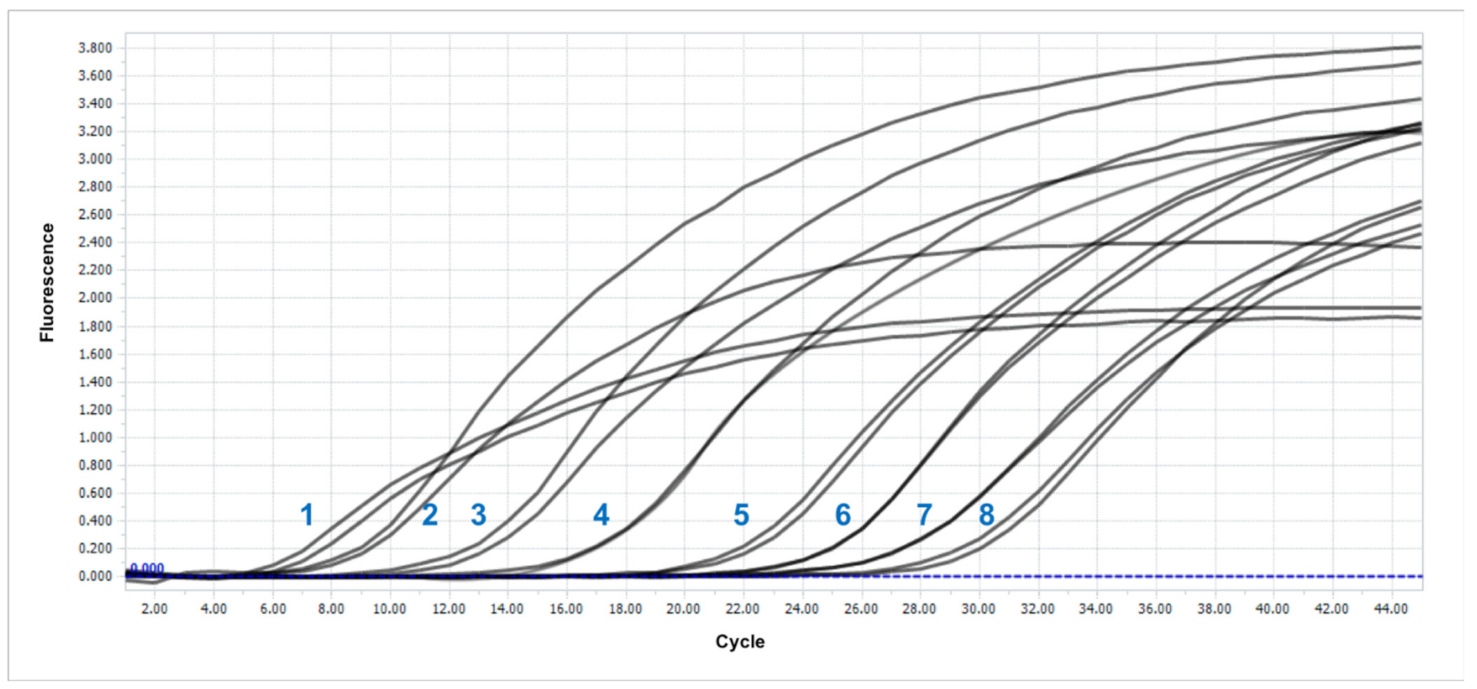
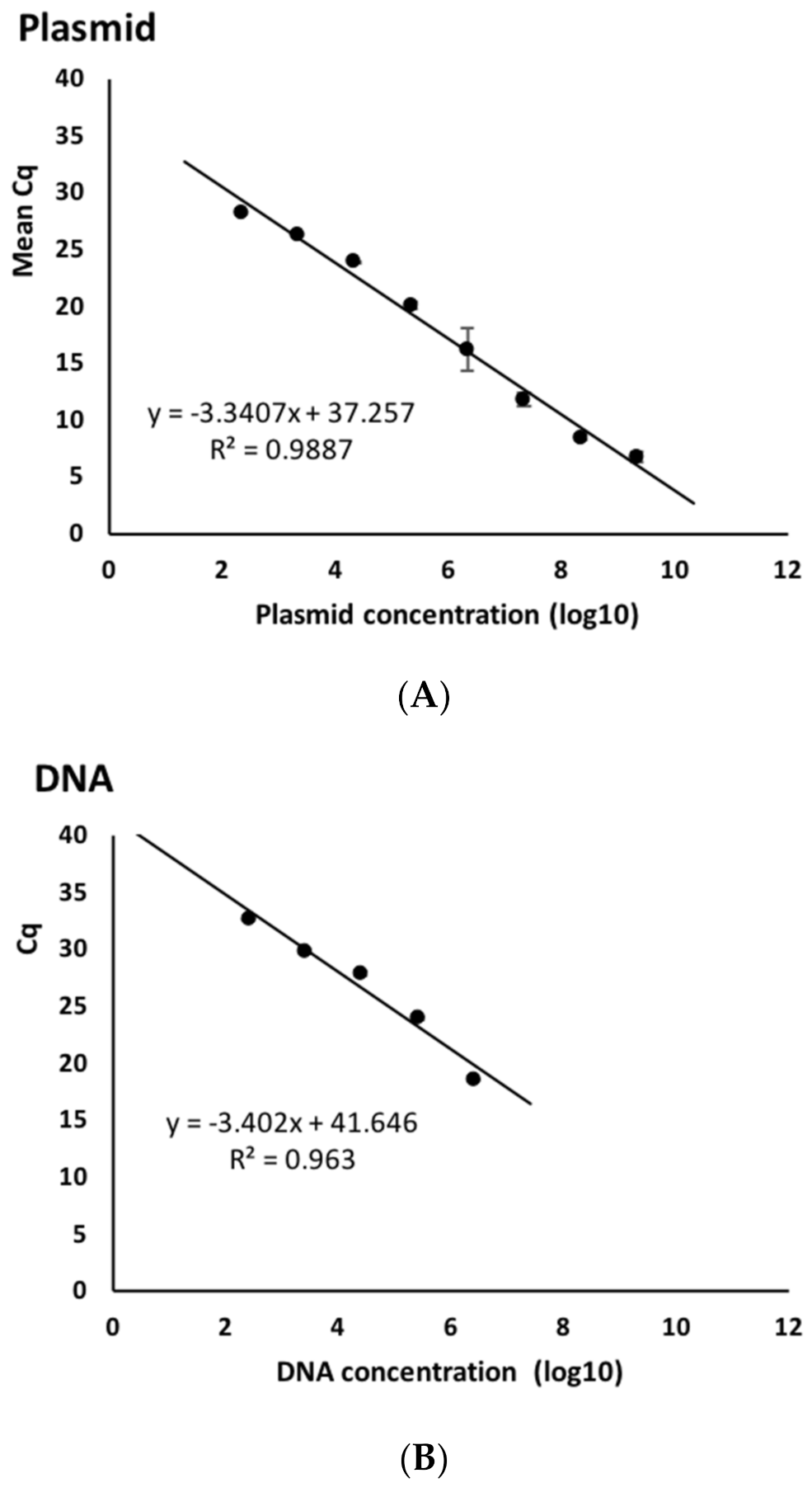
| NCBI Accession | Strain | Isolation Source | Source |
|---|---|---|---|
| JABMCF | C. f. strain LMG 3645 = CFBP3418 | beans | 1957 Klement, Z. |
| JAHEXD | C. f. pv. betae strain CFBP 2402 | beet | 1955 Keyworth, W.G. |
| JAHEWW | C. f. pv. betae strain CFBP 3401 | beet | Keyworth, W. |
| JAFJLX | C. f. pv. flaccumfaciens strain BRIP 70601 | mungbean | Vaghefi, N. |
| CP074439 | C. f. pv. flaccumfaciens strain BRIP:70606 | mungbean | - |
| JAFJLW | C. f. pv. flaccumfaciens strain BRIP 70607 | mungbean | - |
| JAFJLV | C. f. pv. flaccumfaciens strain BRIP 70610 | mungbean | - |
| CP071883 | C. f. pv. flaccumfaciens strain BRIP 70614 | mungbean | - |
| JAFJLU | C. f. pv. flaccumfaciens strain BRIP 70615 | mungbean | - |
| JAFJLT | C. f. pv. flaccumfaciens strain BRIP 70624 | mungbean | - |
| PUEZ | C. f. pv. flaccumfaciens strain CFBP3418 | beans | 1957 Klement, Z. |
| JAHEWX | C. f. pv. flaccumfaciens strain CFBP 3417 | beans | 1958 Lelliott, R.A |
| JAHEWY | C. f. pv. flaccumfaciens strain CFBP 3422 | beans | 1956 Schuster, M.L. |
| JAHEWZ | C. f. pv. flaccumfaciens strain CFBP 3423 | beans | 1957 Schuster, M.L. |
| JAHEWT | C. f. pv. flaccumfaciens strain CFBP 8818 | tomato | 2015 Osdaghi, E. |
| JAHEWS | C. f. pv. flaccumfaciens strain CFBP 8819 | tomato | - |
| JAHEWR | C. f. pv. flaccumfaciens strain CFBP 8820 | tomato | - |
| JAHEWQ | C. f. pv. flaccumfaciens strain CFBP 8821 | tomato | - |
| JAHEWP | C. f. pv. flaccumfaciens strain CFBP 8822 | tomato | - |
| JAHEWO | C. f. pv. flaccumfaciens strain CFBP 8823 | tomato | 2015 Osdaghi, E. |
| JAHEWN | C. f. pv. flaccumfaciens strain CFBP 8824 | tomato | - |
| JAHEWM | C. f. pv. flaccumfaciens strain CFBP 8825 | tomato | - |
| CP041259 | C. f. pv. flaccumfaciens strain Cff1037 | beans | 2015 Osdaghi, E. |
| CP045287 | C. f. pv. flaccumfaciens strain P990 | dry beans | 2015 Osdaghi, E. |
| JAHEXC | C. f. pv. oortii strain CFBP 1384 | tulip | 1967 Barendsen, H. |
| JAHEXA | C. f. pv. oortii strain CFBP 3400 | arum lily | 1990 Janse, J.D. |
| JAHEXB | C. f. pv. poinsettiae strain CFBP 2403 | euphorbia | Starr, M.P. |
| JAHEWU | C. f. pv. poinsettiae strain CFBP 3415 | euphorbia | Dye, D. |
| Species | Strains |
|---|---|
| Genomospecies 1. C. flaccumfaciens | C. f. pv. betae CFBP 2402, C. f. pv. betae CFBP 3401, C. f. pv. oortii CFBP 1384, C. flaccumfaciens 208, C. flaccumfaciens LMG 3645, C. flaccumfaciens VKM Ac-1386, C. flaccumfaciens VKM Ac-1795, C. fpf BRIP 70601, C. fpf BRIP 70606, C. fpf BRIP 70607, C. fpf BRIP 70610, C. fpf BRIP 70614, C. fpf BRIP 70615, C. fpf BRIP 70624, C. fpf CFBP 3418, C. fpf CFBP 3423, C. fpf CFBP 8820, C. fpf CFBP 8821, C. fpf CFBP 8822, C. fpf CFBP 8825, C. fpf Cff1037, C. fpf P990, C. sp. KBS0715, C. sp. MCBA15_005, C. sp. MCBD17_026, C. sp. MCLR17_031, C. sp. MCLR17_034, C. sp. MCLR17_039, C. sp. MCLR17_040, C. sp. MCLR17_042, C. sp. MCLR17_043, C. sp. MCLR17_044, C. sp. MCLR17_045, C. sp. MCLR17_051, C. sp. MCLR17_053, C. sp. MCLR17_054, C. sp. MCLR17_055, C. sp. MCLR17_057, C. sp. MCLR17_058, C. sp. MCLR17_059, C. sp. MCPF17_003, C. sp. MCPF17_018, C. sp. MCPF17_021, C. sp. MCPF17_051, C. sp. MCSS17_005, C. sp. MCSS17_006, C. sp. MCSS17_011, C. sp. MCSS17_016, C. sp. ME12, C. sp. MMLR14_002, C. sp. MMLR14_014, C. sp. UNCCL17, C. sp. VKM Ac-2852 |
| Genomospecies 2 | C. f. pv. poinsettiae CFBP 2403, C. f. pv. poinsettiae CFBP 3415, C. flaccumfaciens MEB126, C. flaccumfaciens S5.26, C. flaccumfaciens UCD-AKU, C. fpf CFBP 3417, C. fpf CFBP 3422, C. sp. 8I-2-2, C. sp. Leaf154, C. sp. MCBA15_007, C. sp. VKM Ac-1796, C. sp. VKM Ac-2889 |
| Genomospecies 3 | C. fpf CFBP 8818, C. fpf CFBP 8819, C. fpf CFBP 8823, C. fpf CFBP 8824 |
| Genomospecies 4 | C. sp. VKM Ac-1376 |
| Genomospecies 5 | C. sp. YC1 |
| Genomospecies 6 | C. sp. PhB115 |
| Genomospecies 7 | C. sp. VKM Ac-1393 |
| Genomospecies 8 | C. sp. JUb34, C. sp. TC1 |
| Genomospecies 9 | C. f. pv. oortii CFBP 3400, C. sp. 18060, C. sp. 24E2, C. sp. MCJR17_020, C. sp. PhB128, C. sp. PhB131, C. sp. PhB134, C. sp. PhB137, C. sp. PhB138, C. sp. PhB141, C. sp. PhB142, C. sp. PhB146, C. sp. PhB170, C. sp. PhB171, C. sp. PhB172, C. sp. PhB190, C. sp. PhB191, C. sp. PhB25, C. sp. PhB42, C. sp. PhB78, C. sp. VKM Ac-2861, C. sp. VKM Ac-2884, C. sp. VKM Ac-2887 |
| Genomospecies 10 | C. sp. MCBA15_003, C. sp. MCBA15_009, C. sp. MCLR17_036, C. sp. MMLR14_006 |
| Genomospecies 11 | C. sp. UNCCL20 |
| Genomospecies 12 | C. sp. MCPF17_002 |
| Genomospecies 13 | C. sp. MCBA15_008 |
| Genomospecies 14 | C. flaccumfaciens JUb65 |
| Genomospecies 15 | C. pusillum DE0005 |
| Genomospecies 16 | C. sp. B18 |
| Genomospecies 17 | C. sp. BH-2-1-1, C. sp. MCBA15_013, C. sp. MCBA15_016, C. sp. YR515 |
| Genomospecies 18 | C. pusillum ATCC 19096, C. pusillum WPL5_2 |
| Genomospecies 19 | C. pusillum DE0370 |
| Genomospecies 20 | C. pusillum AA3, C. sp. 314Chir4.1 |
| Genomospecies21 | C. sp. ISL-83 |
| Genomospecies 22 | C. sp. Ferrero |
| Genomospecies 23 | C. luteum NS184 |
| Genomospecies 24 | Metagenome assembly accession CAJYUP |
| Genomospecies 25 | C. luteum ATCC 15830, C. luteum DSM 20542, C. luteum JCM 1480, C. sp. B8 |
| Genomospecies 26 | C. sp. ER1/6, C. sp. ME26 |
| Genomospecies 27 | C. sp. MCSS17_007 |
| Genomospecies 28 | C. sp. MCSS17_008 |
| Genomospecies 29 | C. oceanosedimentum NS263, C. oceanosedimentum NS359, C. sp. SGAir0471 |
| Genomospecies 30 | C. sp. HSID17257 |
| Genomospecies 31 | C. sp. 1310, C. sp. MR_MD2014 |
| Genomospecies 32 | C. sp. MCBA15_004, C. sp. MCBA15_012, C. sp. UCD-KPL2560 |
| Genomospecies 33 | C. albidum DSM 20512, C. citreum DSM 20528, C. citreum JCM 1345, C. citreum NS330, C. sp. AG1037, C. sp. BH-2-1-1 DE0401, C. sp. Csp1, C. sp. Csp2, C. sp. csp3, Metagenome assembly accession CAJYNE |
| Genomospecies 34 | C. sp. 9128 DE0339 |
| Genomospecies 35 | C. sp. 9128 |
| Genomospecies36 | C. sp. PhB130, C. sp. PhB136, C. sp. ZW137 |
| Genomospecies 37 | C. sp. VKM Ac-1395 |
| Genomospecies 38 | C. sp. MMLR14_010 |
| Genomospecies 39 | C. sp. VKM Ac-2865 |
| Genomospecies 40 | C. sp. MCBA15_001 |
| Genomospecies 41 | C. sp. Leaf183, C. sp. MCLR17_007 |
| Genomospecies 42 | C. herbarum DSM 14013 |
| Genomospecies 43 | C. herbarum S/N-208-OC-R1, C. sp. MCLR17_032 |
| Genomospecies 44 | C. sp. MCBD17_030, C. sp. MCPF17_001, C. sp. MCPF17_011, C. sp. MCPF17_031, C. sp. MCPF17_047, C. sp. MCPF17_052 |
| Genomospecies 45 | C. sp. L6-1 |
| Genomospecies 46 | C. sp. MCBD17_021, C. sp. MCSS17_015 |
| Genomospecies 47 | C. sp. MCBD17_032 |
| Genomospecies 48 | C. sp. MCBD17_008, C. sp. MCBD17_023, C. sp. MCBD17_029, C. sp. MCJR17_043, C. sp. MCJR17_055, C. sp. MCPF17_015, C. sp. MCPF17_046, C. sp. MCPF17_050 |
| Genomospecies 49 | C. sp. MCBD17_003, C. sp. MCBD17_013, C. sp. MCBD17_019, C. sp. MCBD17_028, C. sp. MCBD17_031, C. sp. MCBD17_034, C. sp. MCBD17_035, C. sp. MCBD17_040 |
| Genomospecies 50 | C. sp. Leaf261 |
| Genomospecies 51/Genus | C. ammoniigenes NBRC 101786 |
| NCBI Accession | Plasmid | % GC | Sequence Length | Topology |
|---|---|---|---|---|
| CP018784 | C. pusillum strain AA3 plasmid pCPAA3 | 66.7% | 567,298 | circular |
| CP041260 | C. fpf strain Cff1037 plasmid pCff113 | 66.1% | 113,440 | linear |
| CP045288 | C. fpf strain P990 plasmid pCff1 | 66.1% | 147,310 | circular |
| CP045289 | C. fpf strain P990 plasmid pCff2 | 32.3% | 25,142 | circular |
| CP045290 | C. fpf strain P990 plasmid pCff3 | 35.3% | 22,293 | circular |
| CP066342 | C. sp. YC1 plasmid pCspYC1 | 67.0% | 77,217 | circular |
| CP071884 | C. fpf strain BRIP:70614 plasmid pCff119 | 66.0% | 119,821 | linear |
| CP074440 | C. fpf strain BRIP:70606 plasmid pCff119 | 66.0% | 119,808 | linear |
| CP081962 | C. sp. TC1 plasmid pTCL | 65.6% | 163,762 | circular |
| CP081963 | C. sp. TC1 plasmid pTCS | 67.8% | 41,985 | circular |
| Name | Sequence | Tm | Product Size |
|---|---|---|---|
| Curto-F2 | GAAATGGTGTTATGGCCGGAT | 61.5 °C | 275 bp |
| Curto-D-R | ACGGGTTAACCTCGCCACA | 61.5 °C | |
| Product Sequence | |||
| GAAATGGTGTTATGGCCGGATGTGTATCCCAAGTAGCACGGGGCCCGAGAAATCCCGTGTGAATCTGTCAGGACCACCTGATAAGCCTAAATACTCCCAGATGACCGATAGCGGACAAGTACCGTGAGGGAAAGGTGAAAAGTACCCCGGGAGGGGAGTGAAATAGTACCTGAAACCGTTTGCTTACAAACCGTCGGAGCCTCCTTGTAGGGGTGACGGCGTGCCTTTTGAAGAATGAGCCTGCGAGTTAGTGATATGTGGCGAGGTTAACCCGT | |||
| N° | Plasmid | Genomic DNA | ||||
|---|---|---|---|---|---|---|
| Concentration | Mean Cq | SD | Concentration | Mean Cq | SD | |
| 1 | 2.18 × 109 | 6.76 | 0.45 | 2.59 × 106 | 18.61 | 0.03 |
| 2 | 2.18 × 108 | 8.5 | 0.27 | 2.59 × 105 | 24.01 | 0.09 |
| 3 | 2.18 × 107 | 11.82 | 0.54 | 2.59 × 104 | 27.95 | 0.23 |
| 4 | 2.18 × 106 | 16.21 | 1.9 | 2.59 × 103 | 29.93 | 0.08 |
| 5 | 2.18 × 105 | 20.1 | 0.33 | 2.59 × 102 | 32.66 | 0.09 |
| 6 | 2.18 × 104 | 23.95 | 0.01 | 25.9 | - | - |
| 7 | 2.18 × 103 | 26.37 | 0.01 | 2.59 | - | - |
| 8 | 2.18 × 102 | 28.33 | 0.03 | - | - | - |
| 9 | 21.8 | - | - | - | - | - |
Publisher’s Note: MDPI stays neutral with regard to jurisdictional claims in published maps and institutional affiliations. |
© 2022 by the authors. Licensee MDPI, Basel, Switzerland. This article is an open access article distributed under the terms and conditions of the Creative Commons Attribution (CC BY) license (https://creativecommons.org/licenses/by/4.0/).
Share and Cite
Evseev, P.; Lukianova, A.; Tarakanov, R.; Tokmakova, A.; Shneider, M.; Ignatov, A.; Miroshnikov, K. Curtobacterium spp. and Curtobacterium flaccumfaciens: Phylogeny, Genomics-Based Taxonomy, Pathogenicity, and Diagnostics. Curr. Issues Mol. Biol. 2022, 44, 889-927. https://doi.org/10.3390/cimb44020060
Evseev P, Lukianova A, Tarakanov R, Tokmakova A, Shneider M, Ignatov A, Miroshnikov K. Curtobacterium spp. and Curtobacterium flaccumfaciens: Phylogeny, Genomics-Based Taxonomy, Pathogenicity, and Diagnostics. Current Issues in Molecular Biology. 2022; 44(2):889-927. https://doi.org/10.3390/cimb44020060
Chicago/Turabian StyleEvseev, Peter, Anna Lukianova, Rashit Tarakanov, Anna Tokmakova, Mikhail Shneider, Alexander Ignatov, and Konstantin Miroshnikov. 2022. "Curtobacterium spp. and Curtobacterium flaccumfaciens: Phylogeny, Genomics-Based Taxonomy, Pathogenicity, and Diagnostics" Current Issues in Molecular Biology 44, no. 2: 889-927. https://doi.org/10.3390/cimb44020060
APA StyleEvseev, P., Lukianova, A., Tarakanov, R., Tokmakova, A., Shneider, M., Ignatov, A., & Miroshnikov, K. (2022). Curtobacterium spp. and Curtobacterium flaccumfaciens: Phylogeny, Genomics-Based Taxonomy, Pathogenicity, and Diagnostics. Current Issues in Molecular Biology, 44(2), 889-927. https://doi.org/10.3390/cimb44020060









